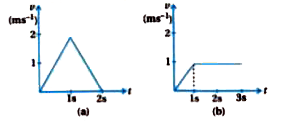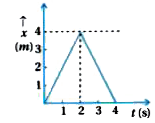(vx,t), and (vyt) diagram for a body of unit mass. Find the force as a function of time.
 Solution in Gujrati
Solution in Gujrati
As shown in figure ( a)
for 0 <t<1secvx=2t
for t<2
for figure ( b)
for 0<t<2secvy=t
for 0<t<2vx=2t
dvdt=9x=2(1)
for 0<t<1
fx=1×2
<t<2
for vy
0<t<1vy=t
ay=dvydt=1
for 1<t
ay=0
0<t<1F=2ˆj+ˆj
1<t<2s=−2ˆj2s
t>2=0
Topper's Solved these Questions
- BOOK - KUMAR PRAKASHANCHAPTER - LAW OF MOTIONEXERCISE - SECTION -E(MULTIPLE CHOICE QUESTIONS) (MCQS)69videos
LAW OF MOTION
- BOOK - KUMAR PRAKASHANCHAPTER - LAW OF MOTIONEXERCISE - SECTION-F (QUESTIONS FROM MODULE)22videos
LAW OF MOTION
- BOOK - KUMAR PRAKASHANCHAPTER - LAW OF MOTIONEXERCISE - SECTION-C(OBJECTIVE QUESTIONS) (VSQS)55videos
LAW OF MOTION
- BOOK - KUMAR PRAKASHANCHAPTER - GRAVITATIONEXERCISE - QUESTIONS PAPER Section - D1videos
GRAVITATION
- BOOK - KUMAR PRAKASHANCHAPTER - MACHANICAL PROPERTIES OF SOLIDS EXERCISE - QUESTION PAPER11videos
MACHANICAL PROPERTIES OF SOLIDS
Similar Questions
The position (x) → time (t) graph of one dimensional motion of a body of mass 0.4 kg. What is the magnitude of impulse of force
 04:04View Solution
04:04View SolutionA block rests on a rough inclined plane making an angle of 30° with the horizontal. The coefficient of static friction between the block and the plane is 0.8. If the frictional force on the block is 10 N, the mass of the block ((in kg) is .......... (Take g = 10 m/s2)
04:04View SolutionArea of F → t graph gives which physical quantity ?
02:20View SolutionA spaceship is stationed on Mars. How much energy must be expended on the spaceship to launch it out of the solar system ? Mass of the spaceship = 1000 kg, mass of the sun =2×1030kg, mass of mars =6.4×1023kg, radius of mars = 3395 km, radius of the orbit of mars =2.28×108km,G=6.67×10−11Nm2kg2
07:08View SolutionWhat is called brittle material ?
View SolutionFigure shows (v_x ,t) and (v_y ,t) diagram for a body of unit mass. Find the force as a function of time.
View Solutionshows (upsilon_(x) , t) and (upsilon_(x) , t) diagrams for a body of unit mass Find the force as a funaction of time .
02:51View SolutionA body of mass m , accelerates uniformly from rest to V_(1) in time t_(1) . The instantaneous power delivered to the body as a function of time t is.
03:14View SolutionIn a projectile motion let v_(x) and v_(y) are the horizontal and vertical components of velocity at any time t and x and y are displacements along horizontal and vertical from the point of projection at any time t .Then
04:47View SolutionIn the circuit shown in figure q varies with time t as q=(t2=16). Here q is in coulomb and t in second.

Find Vab=(Va−Vb)att=3s05:38View SolutionIn the above question if V_(S)(t)=220sqrt2 sin (2pi 50 t) , find (a) l(t) ,(b) v_(R) and (c ) v_(C)(t)
03:46View SolutionThe position of a particle at time t is given by the equation x(t) = V_(0)/A (1-e^(At)) V_(0) = constant and A > 0 Dimensions of V_(0) and A respectively are
06:05View Solutionकोई पिंड प्रारम्भिक वेग v से गतिमान है। उसका त्वरण a समय t के अनुक्रमानुपाती है । समय t पश्चात पिंड का वेग क्या होगा ?
03:07View Solutionएकसमान त्वरित समतलीय गति के लिए सिद्ध कीजिए की - vx=ux+axt तथा vy=uy+ayt
05:19View SolutionFigure shows (v_x ,t) and (v_y ,t) diagram for a body of unit mass. Find the force as a function of time.
01:31View Solution

